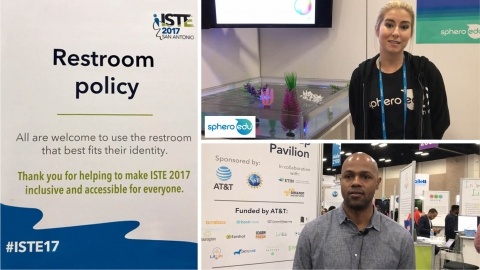News from ISTE 2017
This year’s ISTE was an eye-opener on a number of fronts. Held in San Antonio, where the Texas Legislaturewas at that moment in a Special Session to discuss new legislation specifically about public restroom policies, ISTE welcomed anyone to use multi-user restrooms that “best fit their identity.” I’m not sure how many people saw the signs, but Learning Counsel made sure to get a snapshot so everyone could see this new trade-show reality. What it means is someone of the opposite sex by birth could be in the stall next to you, so the signs gave you fair warning.

In discussion with Erik Harrell, Kahoot’s CEO, I got introduced to their game-based learning platform which now boast some 25 million users in the U.S. K12 sector. The platform works like a quiz show, engaging students in a competitive response App that teachers set up the learning ideas within, and can assign live in class working groups or as homework.
In the fast game that I played, we were picking out which Territories were which in Canada. The Territory highlighted had four optional names to pick from on my mobile phone.
The user interface is a four-square “board” you have to look at for the answer, and is easy to click on to answer unless you are super-excitable and click on the wrong answer as a goof in your haste to beat your opponent. Probably young students are better at this. The entire App is built mobile-ready and has adaptive code for single-player mode.
I found that the platform should have these considerations and precautions for teachers:
- There is a short curve to figure out how to respond, and a “practice” game should always be given if you want to get any surety in students. If they are not terribly coordinated looking up at the screen and down at their devices, you have set them up for failures not on their knowledge but on their hand-eye coordination.
- The platform is limited to brevity in answers, but could potentially still set up larger queries that take longer to reason through and students are not seeking to win on “fastest” but “right” answers, and congratulated for correctness.
- Students more emotionally reticent may not be as active in joining and perhaps grouping would be best for students nine and older to avoid any bias.
- Repetition of concepts, practice without importance assigned to it, are probably the best uses.
- Overuse could attune students to a hyper awareness rather than a relaxed comfort with their knowledge.
For younger students, I give Kahoot a big thumbs-up for ingenuity.

The double-whammy came with meeting Laura Actell of Reading Horizons. This online professional development site for learners is more than a digital delivery, it’s a new technology of reading. Two levels of tech in one.
Research into the English language has shown that is not just a crazy out-of-sync bunch of words like “son” and “sun” which sound the same, but have very different meanings and are spelled differently. In actuality “there are patterns to be learned,” said Actell.
Reading Horizons has a portal full of resources, modeled for content and implementation with classroom clips to show how it’s done. It has real scaffolding and support for teachers.
This ingenuity of language learning is a new “tech” above the hardware and software, couched in a live and online product model.
The trip was great, with innovative items in many booths, like most people, we didn’t get to talk to everyone, but we did find some insights and highlights.
To read the full article click here.


